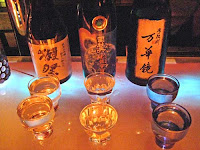 Few days ago, I received an email from Imanishi-san of Harushika Brewery. He told me that he would be in NYC. To be specific, he will be at Union Square Wines & Spirits as a part of Namazaké tasting conducted by Japan Prestige, along with selections from Koshi No Homaré, Shutendouji, Ichinokura, and Kamikokoro.
Few days ago, I received an email from Imanishi-san of Harushika Brewery. He told me that he would be in NYC. To be specific, he will be at Union Square Wines & Spirits as a part of Namazaké tasting conducted by Japan Prestige, along with selections from Koshi No Homaré, Shutendouji, Ichinokura, and Kamikokoro.Here are the quick reviews:
 * Koshi No Homaré Junmai Nama Genshu (SMV: +3, Acidity: 1.7, Rice: Gohyakumangoku) from Niigata. This is a very focused and deep style, with long finish. No mistaking that you are drinking a Genshu.
* Koshi No Homaré Junmai Nama Genshu (SMV: +3, Acidity: 1.7, Rice: Gohyakumangoku) from Niigata. This is a very focused and deep style, with long finish. No mistaking that you are drinking a Genshu.* Shutendouji "Oo-oni" Junmai Ginjo Nama Genshu (SMV: +4, Acidity: 1.7, Rice: Gohyakumangoku) from Kyoto. COmpared to Koshi No Kanbai, rounder, softer approach wth wider flavor range. Balanced elements of rice, fruits, and earthy hints of mushroom. Balanced, complex, and dry, Oo-oni remains a perennial favorite Spring Nama of Nihonshudō.
 * Ichinokura Tokubetsu Junmai Nama Genshu Nigori (SMV: -1, Acidity: 1.8) from Miyagi. Asami-san was back in the States, unvailing a first-time available saké in the States. This is an unpasteurized and undiluted cloudy-style saké, notable for very vibrant, semi-sparkling sensation and deep flavor that seemed drier than the SMV of -1. I immediately wished there was a tempura to go with this saké.
* Ichinokura Tokubetsu Junmai Nama Genshu Nigori (SMV: -1, Acidity: 1.8) from Miyagi. Asami-san was back in the States, unvailing a first-time available saké in the States. This is an unpasteurized and undiluted cloudy-style saké, notable for very vibrant, semi-sparkling sensation and deep flavor that seemed drier than the SMV of -1. I immediately wished there was a tempura to go with this saké. * Harushika Shiboribana Junmai Ginjo Nama (SMV: +3, Acidity: 1.4) from Nara. Only non-Genshu of the lot, Harushika came across as more refined, gentle, with balance of fruits and some mushrooms.
* Harushika Shiboribana Junmai Ginjo Nama (SMV: +3, Acidity: 1.4) from Nara. Only non-Genshu of the lot, Harushika came across as more refined, gentle, with balance of fruits and some mushrooms.* Kamikokoro "Toukagen" Tokubetsu Junmai Nama Genshu(SMV: -11, Acidity: 1.4) from Okayama. Fruitiest and least dry of the lot, this would be perfect saké for before or after dinner, or quite possibly, on Valentine's Day.
* In addition, Kamikokoro had a saké I have never tried before: Koi Junmai Daiginjo (SMV: +2, Acidity: 1.1, Rice: Yamadanishiki, Seimaibuai: 40%). The bottle is made for Koi restaurant, and stylistically, it does not feel like Yamadanishiki-at-40% fruity saké, as the flavor is milder and has moe elements of rice and some rusticness that provides complexity.
******
On the way home, I stopped by Sakagura, because... it was on the way home. After touching base with Kadoi-san regarding the upcoming Dassai Tasting, it was time for dinner.

 For the dishes, I had Chicken meat balls (鶏のつくね), Spanish mackeral wrapped rice balls (サンマのおにぎり), and picked plums from Wakayama Prefecture (紀州の梅干). While the saké was too bold for chicken and rice balls, it was perfect for mildly sweet and tart umé pickled plum.
For the dishes, I had Chicken meat balls (鶏のつくね), Spanish mackeral wrapped rice balls (サンマのおにぎり), and picked plums from Wakayama Prefecture (紀州の梅干). While the saké was too bold for chicken and rice balls, it was perfect for mildly sweet and tart umé pickled plum.



















